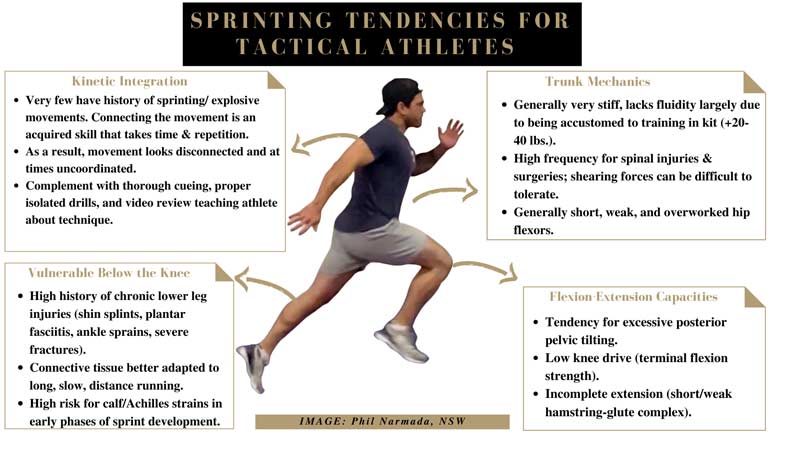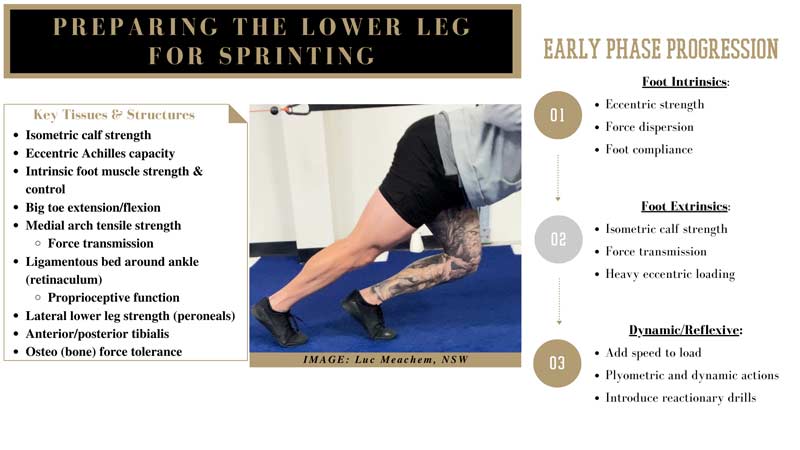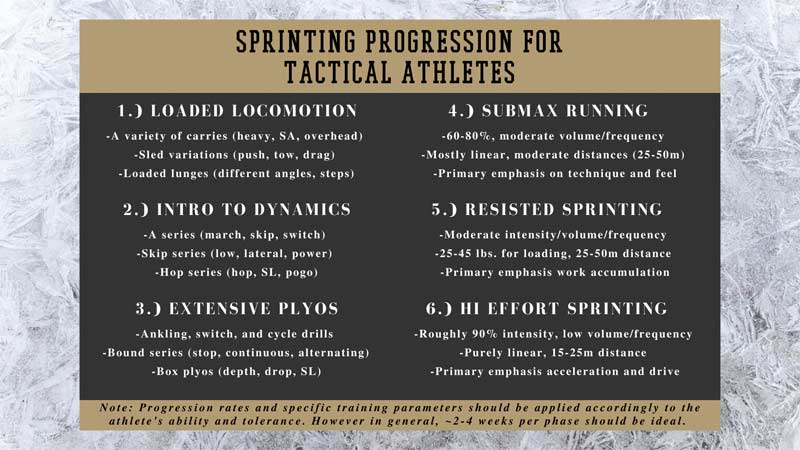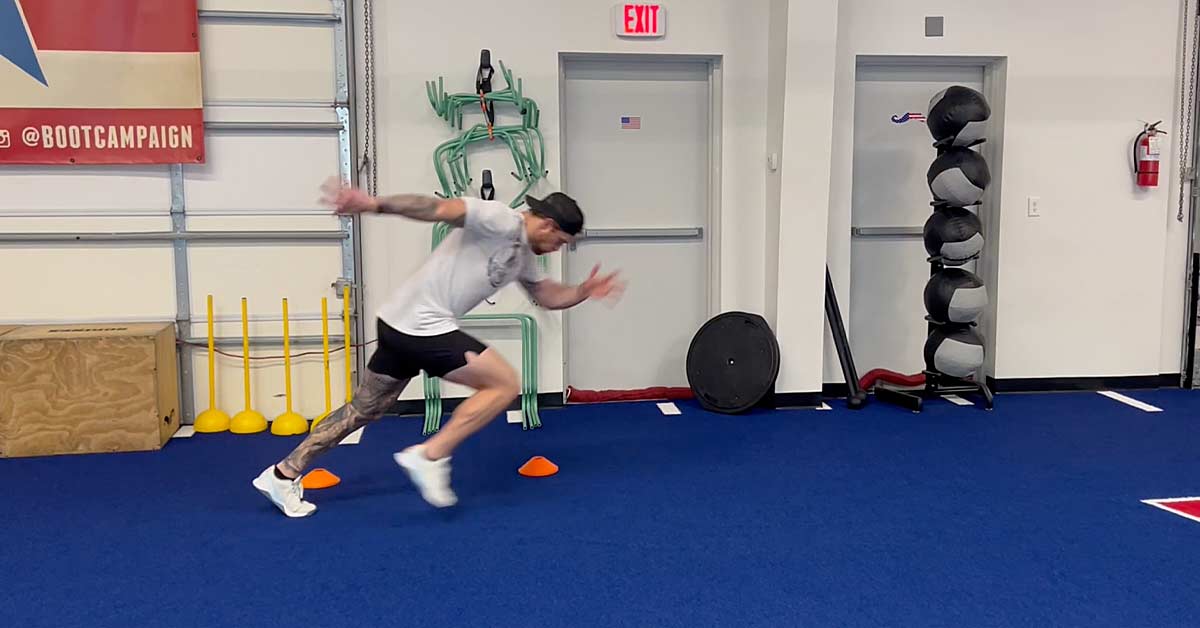Conventional military training has been well-documented and is not exactly adored by many in the strength and conditioning field. These tactical athletes are subjected to extraordinary demands, involving both extreme intensities and volumes. Across the wide spectrum of physical training, tactical athletes specifically accumulate a very high volume of running mileage (almost all at long, slow distances while also under load), push-ups, sit-ups, and pull-ups. There are consequential outcomes produced by this volume—working with athletes who have hundreds, if not thousands, of miles accumulated on long, slow runs and virtually no history of sprinting training makes for a tough task.
Of all the difficulties I’ve encountered in the six years I’ve worked in the tactical space, nothing quite compares to that of teaching these athletes how to sprint. It’s not only that we need to teach them a completely new endeavor/skill, but what really proves challenging is helping them unlearn poor mechanics they’ve developed over the years.
Of all the difficulties I’ve encountered in the six years I’ve worked in the tactical space, nothing quite compares to that of teaching these athletes how to sprint, says @danmode_vhp. Share on XIn addition to the technique aspects, we also must consider the biomechanical and physiological adaptations that have already occurred. Although this isn’t always the case, most tactical athletes have greater amounts of relative type 1 (slow twitch) fibers, more robust aerobic energy systems, and connective tissue that is more conducive to distance running (brittle, collagen breakdown, oxidative, poor elasticity).1 Furthermore, tactical athletes are at a much higher risk for developing chronic overuse injuries, particularly in the lower leg and foot, due to years of mechanical overloading.2

With this population, I routinely see an injury history of shin splints, calf strains, plantar fasciitis, Achilles tendinitis, chronic ankle sprains, and turf toe. To a lesser extent, but still prevalent, a history of compartment syndrome and severe ankle/lower leg fractures due to bad jump landings are also good to be prepared for. Injuries at virtually any part of the body will carry some level of significance, but injuries below the knee are especially influential for sprinting mechanics and capacity. Given this high-frequency injury history, it’s an absolute priority that you’re cognizant of the demands sprinting places on the lower leg and foot.
While the ground reaction forces experienced during sprinting can commonly reach 3-5xBW, the joint reaction forces at the ankle can exceed 10xBW3 and are impossible to replicate elsewhere in training. So, if nothing else, be sure that the athlete is loaded appropriately as they progress into their sprint training.
Phase 1: Develop Strength Below the Knee
Building off the point above, I would say the first step in sprinting for tactical athletes is establishing adequate strength below the knee. In short, you want to consider the intrinsic foot strength, the strength of the calf muscles (namely isometric strength), the eccentric capacity of the Achilles tendon, and then the ability to load these structures heavy and under velocity.

Beyond the strength component, we also want to provide a good amount of attention to the connective tissue. It is best to strengthen the connective tissue by applying a variety of parameters to your normal training session and to individual movements, like the ones provided above. Generally speaking, tendons respond best to heavy loads (90%+) done with eccentric tempo and need to be stressed at end range.4 Ligaments respond more to a variety of isometric conditions:
- Long duration
- Yielding
- Overcoming
- Under load
- Short pulsing
The optimal loading parameters for ligaments include submaximal (60%–80%) loads performed through full range of motion.5 Fascia, your global connective tissue, is optimized by utilizing omnidirectional movements, under a variety of stimulus and submax loading conditions (45%–65%), and movements that promote reflexive, ballistic actions.5 Although it’s beyond the scope of this article, also consider the demand for soft tissue care and restoration. This will become imperative for keeping injury risk lower.
I should also quickly note that there is a great demand for proprioceptive function here as well. In particular, the retinaculum that envelops the ankle plays a significant role in sensorimotor function. Retinaculum is a fibrous band of thickened fascia that is enriched with sensory bodies throughout the tissue.6 This means that we need to consider reactive and unanticipated drills and movements as a part of the work-up for sprinting.
Video 1. Lower Leg Analysis.
Phase 2: Introduction to Moving Fast
I say this with the utmost respect for the tactical crowd—and they are extremely impressive in their own realm—but there is quite a disconnect between most tactical and conventional athletes when it comes to dynamic movement (jumping, bounding) and especially sprinting. As I mentioned in the opening, this is an entirely new endeavor for them, so in fairness, a learning curve should be expected.
I say this with the utmost respect for the tactical crowd—there is quite a disconnect between most tactical and conventional athletes when it comes to dynamic movement, says @danmode_vhp. Share on XI think the most important thing with this is being very clear and descriptive early on about what’s involved with sprinting and what they are working toward. I’ve had a lot of success “reverse-engineering” this: describing the full end goal first and then breaking down each component as we go along. This can involve breakdowns on the whiteboard, video analysis discussing their movement patterns, or simply a good amount of repetition. As long as you are providing the athlete with context and feedback along the way, you’re doing your job. This can’t be rushed, and it cannot be treated as trivial; given the characteristics of this population, we can’t give them the keys to the Corvette and then leave them to figure out by themselves how fast it goes.
As for the training itself, I work through a standard framework for introducing speed and dynamic movement to my athletes. This includes a timely progression of general dynamics, rudiment plyos, and isolated sprinting drills as we build into submax sprinting. We generally break this out over a two- to four-week period and perform everything at submax velocities with an exclusive priority on technique and development.
The overall goal of this phase is to, quite literally, allow them to experience what it feels like to move their body faster while looking to sequence movements together with rhythm and coordination demands. I believe the biggest challenge to this, aside from a lack of exposure, is they don’t have the advantage of provided extrinsic stability that they’re accustomed to. Because of this, they are more inclined to not only feel very awkward but also have a lot of difficulty with connecting movement. Things look very choppy and disconnected as a result, and that’s okay—be patient in this phase.

Phase 3: Developing Foundational Speed
Once we’ve cleared phase two, we can now have athletes start practicing full runs and introduce acceleration. A few things to be generally aware of here:
- These athletes perform almost all their work (and training) in kit. This creates significant compression on the anterior trunk, and on average adds 20–40 pounds on top of body mass. Because of this, I actually utilize resisted running as a precursor to full-tilt sprinting. I know this is paradoxical in the conventional sense, but in this realm, it’s pragmatic. Believe me, they will sprint better with an added 10–15 pounds.
- Acceleration will be significantly challenging to coach early on. I’ve found that athletes can assimilate top end speed because at least it’s somewhat reflective of the shapes and positions seen in long, slow, distance running. Acceleration, on the other hand, is completely unrelatable. I believe the athletes feel completely out of sorts trying to stay low to the ground. As such, objects and implements may be your friend here.
- Never say the words “100%” or “max effort” out loud. No matter what your training goal or directive is, I never, ever, instruct them to go above 90%. You gotta remember, this is a group of individuals who simply do not adhere to warning signs or fear outcomes. So, when they hear “100%,” it may incentivize them to push beyond something they’re capable of handling, especially with something new to them.
I mentioned that acceleration can be particularly tricky to teach. What I’ve found the most success with is using more constraint with this phase. A simple drill I’ve used is holding a PVC pipe as a physical and visual barrier for them to stay below. Another I’ve found success with is the two-step cone, which isolates the initial burst and gives them a single-point focus to emphasize their actions. Additionally, I use unloaded sleds here, so they have the opportunity to leverage their upper body into the sled to better mimic the leg action that’s desired in the acceleration phase.
Video 2. Two-step cone acceleration drill.
Some additional constraint drills I often use and have found effective include wickets, wall drills, and modified running to help clean up technique and cadence. Be mindful that the bar for adaptation here is relatively low, so almost anything will have an impact. The keys for success with improving sprinting in the tactical space are simple:
- Clear instruction.
- Good consistent cueing using basic drills and parameters.
Really, athletes just need an opportunity for repetition and feedback, and they are good-enough athletes and learners to pick it up to a point of proficiency.
Video 3. Tactical Sprint Analysis.
Closing Observations
Tissues tear when they are loaded faster than the body can respond. The most important factor with sprinting and tactical athletes is steady, logical progressions and sufficient prep work. You should always be conservative on intensity and volume prescriptions: remember, “60%” to us is “85.5%” for them.
The most important factor with sprinting and tactical athletes is steady, logical progressions and sufficient prep work, says @danmode_vhp. Share on XAdditionally, don’t be hesitant to have them perform resisted sprints or even use lightweight vests (< 10 pounds). Given their history of working and training in kit, this will actually be more comfortable for most, even at higher speeds. Remain very cognizant of the lower leg and foot and understand the common mechanisms of injury. There are huge differences in program and approach between an athlete coming off an Achilles tear and another coming off a Lisfranc fracture. The best instruction is clear and constructive, and from my experience, the best review is breaking down video with them.
I had a huge fear of teaching sprinting with this population, and as a result, I avoided it for years—one of the saddest mistakes of my career. But speaking especially to younger coaches, you just have to jump in and do it. It will be rough at first, but as long as you don’t put them in positions to get hurt, you can work through your errors and inefficiencies. I promise you there is no better situation where “keep it simple, stupid” applies more than teaching tactical athletes to sprint.
Since you’re here…
…we have a small favor to ask. More people are reading SimpliFaster than ever, and each week we bring you compelling content from coaches, sport scientists, and physiotherapists who are devoted to building better athletes. Please take a moment to share the articles on social media, engage the authors with questions and comments below, and link to articles when appropriate if you have a blog or participate on forums of related topics. — SF
References
1. Plotkin, D.L., Roberts, M.D., Haun, C.T., and Schoenfeld, B.J., “Muscle Fiber Type Transitions with Exercise Training: Shifting Perspectives.” Sports. 2021;9(9):127.
2. Lovalekar, M., Perlsweig, K.A., Keenan, K,A., et al. “Epidemiology of musculoskeletal injuries sustained by Naval Special Forces Operators and Students.” Journal of Science and Medicine in Sport. 2017;20(6).
3. Clark, K. and Weyand, P.G. “Are running speeds maximized with simple-spring stance mechanics?” Journal of Applied Physiology. 2014;117(6):604–615.
4. Monte, A. and Zamparo, P. “Correlations between muscle-tendon parameters and acceleration ability in 20 m sprints.” PLoS ONE. 2019;14(3):e0213347.
5. Maas, H. and Sandercock, T.G. “Force transmission between synergistic skeletal muscles through connective tissue linkages.” Journal of Biomedicine and Biotechnology. 2010.
6. Maas, H. “Significance of epimuscular myofascial force transmission under passive muscle conditions.” Journal of Applied Physiology. 2018;126(5):1465–1473.





